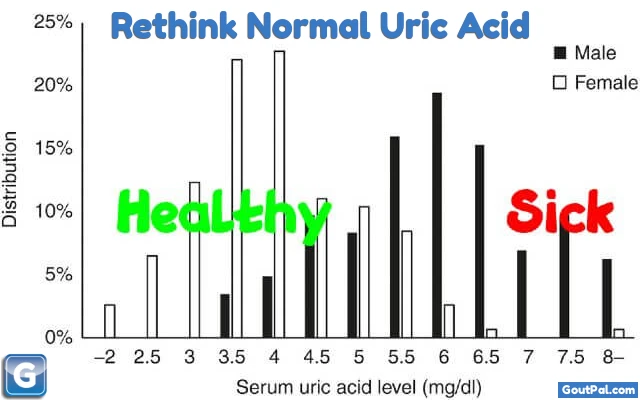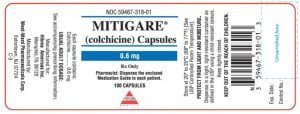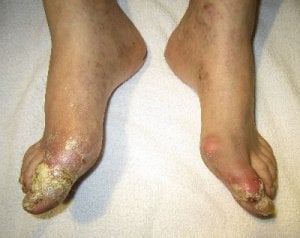The danger of normal uric acid levels is not widely recognized.
In my experience, from discussions in the gout forums, personal discussions with friends, and discussions with doctors in my local group practice, normal uric acid levels are the biggest danger to gout patients.
Back in 2010, after a couple of years of uncertainty and research, I published Normal Uric Acid Blood Test? No Thanks!
I hoped that this would be a rallying call to campaign against the use of normal reference ranges in uric acid management. Though the campaign never took hold, it is good to note that professional rheumatologists in Europe, Britain, and America have strongly encouraged the concept of managing gout to safe uric acid levels.
Unfortunately, the concept of safe personal uric acid levels has not yet reached many frontline medical personnel. You have been warned. If you want the right treatment when your uric acid blood test results show normal, you will probably have to fight for your rights.
As yet, I have seen no independent research that quantifies how widespread the abuse of normal uric acid levels is. I will summarize my own research, cite the medical facts that matter, then leave it to you. Of course, you are not entirely alone, as we have the gout forum where you can get personal support to understand your uric acid levels, and learn precisely what to do to make uric acid safe.
Uric Acid Normal Range: The Problem
At normal blood temperatures, uric acid crystals form at 6.8mg/dL (0.4 mmol/L). This is called the saturation point or crystallization point. Importantly, it is affected up or down due to many factors. The most common factor is temperature. Because uric acid crystals are less soluble at lower temperatures. Also, joint temperature tends to reduce as we age. Therefore, 6.8 is too high for most people.
Uric acid blood test results are normally accompanied by a reference range for “normal” values. Which is often referred to as Uric Acid Normal Range. This is a statistical calculation based on the results from samples used by the testing laboratory. Reference ranges vary widely from lab to lab, but the normal range is always higher than crystallization point for men, and frequently for women.
Uric Acid Normal Range: The Research
I do not hold the following out as high-quality research, and I have not kept references. However, I am convinced that it reflects widespread practice, and it is very easy for you to conduct your own personal research to verify this.
Uric Acid Normal Range Research: Lab Results
I got my data by searching medical investigations, as described below. I have not noted the specific reports, but I’m sure you can achieve similar results.
I searched for “uric acid reference range calculation,” which yields the “normal” range for several laboratories. The ranges of my random sample are:
Male mg/dL Female mg/dL 2.10 to 8.50 2.00 to 7.00 1.85 to 7.06 1.85 to 6.05 3.60 to 7.70 2.50 to 6.80 3.60 to 8.20 2.30 to 6.10 3.40 to 7.00 2.40 to 5.70 The very fact that they report different ranges for males and females should set alarm bells ringing. Yes, pre-menopausal females do have a lower likelihood of gout, but this is because physiologically they are likely to have lower uric acid levels – at the same uric acid level, they have the same gout risk.
Uric Acid Normal Range Research: Medical Practice
My doctor belongs to a group practice of around 10 qualified general practitioners plus support staff. When I decided to start allopurinol I arranged uric acid blood tests followed by consultations. 3 out of 4 were extremely reluctant to prescribe (or increase) uric acid lowering treatment because my test results were “normal”. All these results were above 6.8 mg/dL and I had a thumb-sized tophus on one elbow, with smaller tophi near other joints.
At the first visit, I had to argue strenuously for starting allopurinol, and repeat the same arguments on the next two visits to get an increased dose. I made appointments with different doctors on each occasion. Then, I had to fight my way to 300 or 400 mg allopurinol per day before finding a doctor who understood my situation. Together, we worked towards the maximum daily dose, and gout attacks faded to zero within a few months.
The significant facts during my arguments were my unwillingness to accept a statistical average as a medical action point, and professional recommendations. I am based in the UK, and British rheumatologists recommended a top limit for uric acid of 5 mg/dL (0.30 mmol/L) for anyone who had suffered a gout attack. Importantly, the recommendations were published over 4 years before my first allopurinol consultation. American rheumatologists adopted a similar standard only last year (November 2012).
Uric Acid Normal Range: The Truth
The only truth that really matters for normal uric acid levels is that they are irrelevant. Professional rheumatologists around the world have recommended 5 or 6 as the upper maximum for anyone who has ever suffered a gout attack.
It is interesting to note that there is a great difference between uric acid test results as a diagnostic tool prior to confirming gout, against uric acid test results during treatment. In Interpretation of Diagnostic Tests By Jacques Burton Wallach, the author explains important factors that need to be considered when interpreting test results. He makes many interesting points about how test results should be interpreted. The normal uric acid levels truth is revealed when he explains the different interpretation when diagnosing unknown gout versus measuring known gout.
Those interested in math, will be intrigued by the comparison at page 4. If a blood test reveals normal uric acid it can be regarded as a negative test for gout. In diagnostic cases, where there is no prior probability of gout, the negative result is likely to be correct in 99% of cases. But the correct interpretation when gout has already been diagnosed means that normal test results will still have gout in 47% of cases.
In a nutshell, if you have gout, forget normal uric acid levels – they are statistically and medically meaningless.

Uric Acid Normal Range: Next Steps
If you have had a gout attack and your uric acid is above 5, you must get it down to 5 or below. There are exceptional circumstances that allow 6 as the upper limit. Your doctor, or the gout forum, can help you understand what these circumstances are. Also see High Uric Acid Levels guidelines in this series, and Normal Uric Acid Level Chart.
If you have never had a gout attack and your uric acid is above 5, your situation is not so straightforward. As explained in the aforementioned High Uric Acid Levels guidelines, you need to monitor joints closely for the first signs of redness and swelling. See a rheumatologist for joint fluid analysis during these early signs of potential gout. Treat uric acid early, and you may never experience a gout attack.
Forget normal uric acid levels – stay safe!
Leave Uric Acid Normal Range to browse other Uric Acid guidelines
Uric Acid Normal Range Related Topics
Please remember: to find more related pages that are relevant to you, it's usually faster to search for your biggest normal uric acid concern.
Uric Acid Level Chart
This list of Vital Uric Acid Level Charts shows the graphs and tables that explain why you need to use medical urate levels.
Uric Acid Level According To Age
As with many aspects of our bodies, average uric acid levels change according to age. So there are statistics that show age-related uric acid levels. However, I regard these as insignificant. Because gout occurs at the same uric acid levels irrespective of your age. So you should always aim to be below 5 or 6 mg/dL, as advised by your doctor.
High Uric Acid
High uric acid levels are dangerous. How do you know what is too high? Do not be confused by numbers. See how to set your personal high level and avoid gout.
Please give your feedback
Did this page help you? If yes, please consider a small donation. Your donations help keep GoutPal's gout support services free for everyone.
If not, please tell me how I can improve it to help you more.
- YouTube
- The gout forums.








